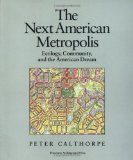
Mesa del Sol’s CEO
CEOs have cottoned on to the off-grid concept as a way to make more money. So watch out – if you’ve been planning to buy that cabin in your local wood, then get in now before it’s snapped up by a computer programmer from Seattle. For the full story, see: Business Week, 12th December 2005:
“ON THE EDGE of Albuquerque, work has started on one of the largest and most technologically tricked out communities in the nation, offering 310 sunny days a year in a climate balmier than Colorado’s, cooler than Arizona’s, and cheaper than either. A place where you can hit the slopes in the morning, then jam in some collaboration with co-workers in India before David Letterman. A desert idyll for those who want to go off the grid but remain connected; keep their New Economy-size paychecks on a New Mexico-priced lifestyle.
Mesa del Sol, designed by New Urbanism guru Peter Calthorpe (buy his book on the next page – click more), will be the first place of its kind built from scratch and targeted at the creative class. A big marketing push will be made to coastal knowledge workers looking to cash out of their million-dollar split levels, move inland, and work remotely for their companies.
Mesa del Sol’s developer is Forest City Enterprises Inc. (FCE.A ), the same company behind the “sustainable” Stapleton development outside of Denver — where houses are so hot there’s a lottery to get on the waiting list — and the MetroTech Center in Brooklyn. The company’s professorial co-chairman, Albert B. Ratner, hands out f copies of Richard Florida’s book, The Rise of the Creative Class, to pretty much anyone who will take one. Like Florida, Ratner believes that the future of work belongs to those who will log their hours when they want, how they want, and, most important, where they want.
 The Next American Metropolis : Ecololgy, Community, and the American Dream – buy it now on Amazon
The Next American Metropolis : Ecololgy, Community, and the American Dream – buy it now on Amazon
FAR-FLUNG EFFICIENCY
At Sun Microsystems Inc. (SUNW ), nearly 50% of employees can work from home, cafes, drop-in centers, a company office, or some combination thereof — saving the company $300 million in real estate costs. In 2003 Agilent closed 48 U.S. sales offices and swiftly instructed all the employees to work from home. Today, 70% of Agilent’s workforce is connected remotely either some or all of the time. The company estimates that these virtual workers cost 60% less.
Indeed, at many companies across America, the most innovative new product may be the structure of the workplace itself.
HIGH-SPEED HAPPY PEOPLE
Companies are finding that allowing workers the flexibility to work remotely contributes to increased productivity. Sun says its virtual workers are 15% more productive than their office-tethered brethren. “Our people working these remote schedules are the happiest employees we have, and they have the lowest attrition rates,” says Sun’s MacGowan. The need to seduce and keep star talent also plays a role. “Would I rather settle on someone mediocre in the Bay Area, or get the best person in the country who is willing to work remotely?”
Not that offices will ever become obsolete, says Peter Calthorpe. But companies used to figure the talent would come to them. More and more, they are going to have to figure out how to get the work to the talent.
2 Responses
Yeeuugh. A commune full of yuppies typing away on their computers. Sounds like dreary.
Thanks for pointing out this article – it confirms the boondocks trend is building stedily, — it is the future for the US – falling prices in city centres and rising prices in the boondocks